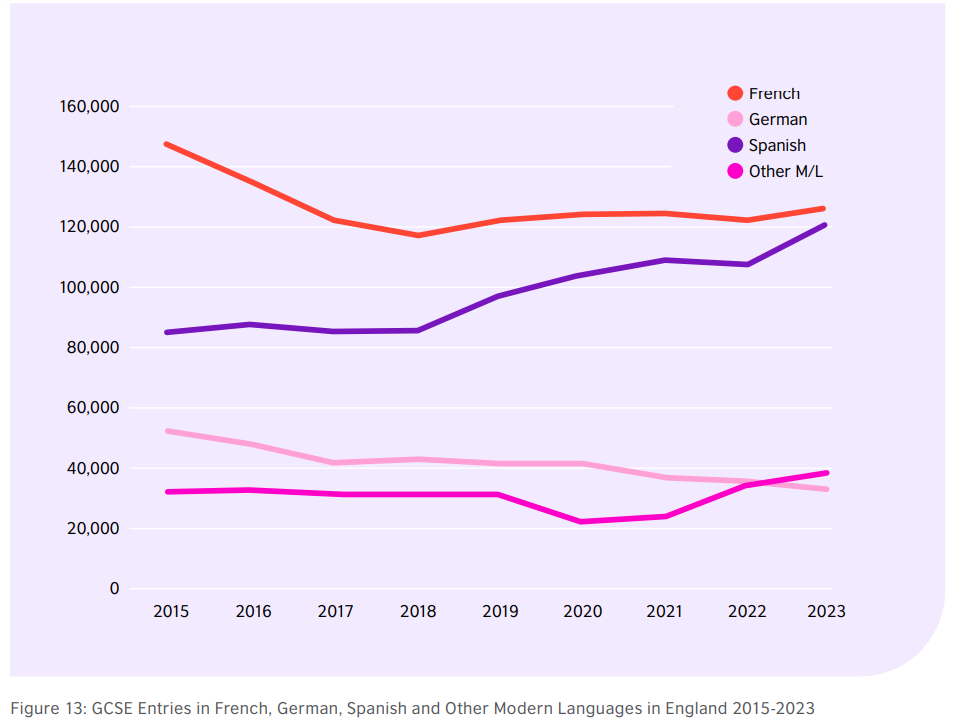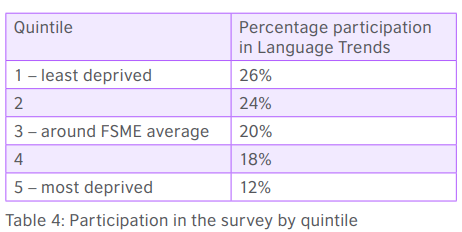Six Insights on Language Learning in Schools in England
British Council reports give us the latest trends within the sector
The annual Language Trends reports published by the British Council are arguably the most important pieces of data we have on the situation for language learning in the UK.
This week, Language Trends England was released for 2024. Read the full report here.
Based on survey responses from teachers across England as well as uptake data from JCQ (Joint Council for Qualifications), it offers a window not only into the current trends but also where we might be heading in the future.
I watch these reports closely because they help to identify some of the challenges we face and where changes within the sector are having an impact. They also give teachers a voice when they are rarely heard within the national dialogue.
Though the report does not survey learners, it does offer our best view into schools and analyses the sector from a variety of angles on a yearly basis. (Click here to read my 2021-22 report based on 5,800 learner surveys conducted by MFL Mentoring).
Here are six key points I’ve noted in the report this year. I’d be keen to hear your thoughts in the comments.
Language Profiles
French remains the most commonly taught language in both primary and secondary schools though Spanish is increasingly popular. Languages other than these two are rarely taught in primary; German was taught in only 3% of responding primaries.
At secondary, German is offered in just less than 40% of schools and they are less likely to be the most deprived schools. However, the most deprived schools do have the highest rates of pupils with English as an Additional Language making them the most linguistically diverse.
Transition from Primary to Secondary
55% of primary schools reported no contact with local secondary schools and only 15% reported that a language teacher from the local secondary comes to teach in their school. These figures have not improved over the last five years and suggest that the majority of primary teaching is being done by non-specialists.
62% of secondary schools reported that there has been little change in the preparedness for language learning of their Year 7 pupils, while 20% felt they were less prepared. Again this demonstrates little change despite policy initiatives to improve learners knowledge and skills when reaching secondary school.

GCSE Uptake
We will have to wait till August for JCQs uptake figures for 2024; however, 25% of teachers reported more pupils taking languages and 20% reported fewer pupils. 17% of schools made languages compulsory at GCSE (this is far rarer in other UK nations).

International Engagement
Links between English schools and those abroad dropped during the pandemic and have not yet recovered. 66% of primary schools who were surveyed had no engagement with a school internationally, compared to 36% of secondary schools and 6% of independent schools.
Only 2% of primary schools had a language assistant; whereas it is closer to a third in secondary schools and two thirds in independent schools. Interestingly, 48% of secondary schools reported they were not aware of the Turing scheme and another 46% were aware but had not applied. This level of engagement with Turing is shockingly low given the importance of the scheme for funding international opportunities in education and training post-Brexit.
Recruitment of Staff
Two thirds of schools reported an issue with recruiting secondary school language teachers. As Vicky Gough from the British Council points out “this problem is cyclical and has been growing for years.”
As fewer pupils opt for languages, there are decreasing numbers of students all along the pipeline. University departments are closing and fewer linguists are returning to schools to teach the next generation.
Socio-economics
It’s worth noting that the response rate for the surveys are highest in independent schools and lowest for the most deprived schools. This isn’t particularly surprising as more affluent schools tend to engage more in language learning but it’s something we should be aware of when looking at the data. It’s also something we should help the research team to address by encouraging less affluent schools to participate. Their voice is particularly important given a tendency for learners to view languages as a subject for the middle classes.

In relation to responses from secondary schools, the authors of the report offer the following note:
“We want all schools to participate in Language Trends, so that we have a broad and balanced report. Thus, the statistically significant overrepresentation of schools in Quintile 1 (least deprived) means that the data which follow may not be truly representative of the social spectrum.” p.22


Language Trends is published annually for England, Northern Ireland and Wales. Dr Ian Collen and his team at Queen’s University Belfast write the reports which are published by the British Council.
For more insights from me, please subscribe and follow me on X and LinkedIn.
Language Unpacked is my initiative to help learners explore the world through languages and cultures. For resources and to book a schools workshop, visit my website.



